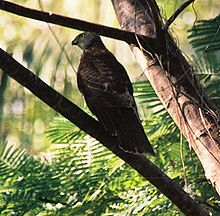Fiji hawk
| Fiji hawk | ||||||||||
|---|---|---|---|---|---|---|---|---|---|---|

Fiji hawk ( Accipiter rufitorques ) |
||||||||||
| Systematics | ||||||||||
|
||||||||||
| Scientific name | ||||||||||
| Accipiter rufitorques | ||||||||||
| ( Peale , 1848) |

The Fiji Goshawk ( Accipiter rufitorques ) is a bird of prey in the family Accipitridae (Accipitridae). It used to be considered specific to the banded goshawk ( Accipiter fasciatus ), which is native to Australia and New Caledonia. It is now viewed as a distinct species. With its predominantly gray plumage, pale pink on the underside and collar, the Fiji hawk is unmistakable in its distribution area, the Fiji islands.
description
The Fiji hawk is a medium-sized member of the genus Accipiter . The body length is 30 to 40 cm. It has relatively long legs and a long tail. The species is unmistakable due to the plumage in its range: head, back, tail and wings are gray, while the underside and collar are pale pink. Young animals differ in the plumage from the adult animals. They are completely brown with a striped chest. The species shows a sexual dimorphism : Female individuals are larger than their male counterparts.
distribution and habitat
The Fiji hawk is endemic to the Fiji Islands . There it occurs on the main island of Viti Levu and on Vanua Levu , Taveuni , Kadavu , Gau and Ovalau . In addition, the species is said to have occurred earlier on the Lau Islands in Fiji. In addition, outside Fiji, on the island of ʻEua in Tonga , fossil bones were found that are attributed to the Fiji hawk. The species inhabits a wooded habitat that ranges from natural rainforests to coconut plantations to urban gardens and parks.
Systematics
In the past, the Fijian hawk was considered specific to the banded goshawk ( Accipiter fasciatus ), which is native to Australia and New Caledonia. According to today's system, both forms represent their own species within the genus of the hawks and sparrowhawks ( Accipiter ) in the family of the hawk-like (Accipitridae). These are to be placed in the order of the birds of prey (Accipitriformes).
nutrition
The Fiji hawk feeds on birds up to the size of a pigeon , and it also eats insects, rodents and reptiles. It is also recorded that it feeds on freshwater shrimp belonging to the Palaemonidae family, as well as freshwater fish. The bird of prey either hunts from a sitting position or in flight, attacking either in a slow, creeping glide or in a fast attack with powerful wing flaps.
Reproduction
The Fiji hawk breeds seasonally, with a breeding season between July and December. The main breeding season is in September and October. The nest is a platform made of branches that is high up in a thinly overgrown tree. The size of the clutch is between two and three (sometimes four) eggs. Two chicks usually fledge.
Existence and endangerment
Fiji hawks occasionally prey on chickens and are therefore often hunted. However, they are very common and live in great density. The IUCN categorizes the Fiji hawk in its Red List of Endangered Species as not endangered.
Individual evidence
- ^ A b c H Douglas Pratt, Bruner, Phillip & Berrett, Delwyn: The Birds of Hawaii and the Tropical Pacific . Princeton University Press, Princeton 1987, ISBN 0-691-08402-5 , p. 356.
- ↑ a b c d e Thiollay, JM (1994): Family Accipitridae (Hawks and Eagles) in del Hoyo, J .; Elliot, A. & Sargatal, J. (editors). (1994). Handbook of the Birds of the World . Volume 2 : New World Vultures to Guineafowl. Lynx Edicions. ISBN 84-87334-15-6
- ^ David Steadman: Extinction and Biogeography in Tropical Pacific Bird . University of Chicago Press, 2006, ISBN 978-0-226-77142-7 , pp. 360-361.
- ↑ David Steadman: Biogeography of Tongan birds before and after human impact . In: Proceedings of the National Academy of Sciences . 90, No. 3, 1993, pp. 818-822. doi : 10.1073 / pnas.90.3.818 .
- ^ Fergus Clunie: Harriers fishing Archived from the original on October 17, 2008. In: Notornis . 27, No. 2, 1980, p. 114.
- ^ Fergus Clunie: Nesting season of the Fiji Goshawk Archived from the original on October 18, 2008. In: Notornis . 28, No. 2, 1981.
- ↑ Accipiter rufitorques in the endangered Red List species the IUCN 2012. Posted by: BirdLife International . Retrieved September 2, 2013.
Web links
- Accipiter rufitorques inthe IUCN 2013 Red List of Threatened Species . Listed by: BirdLife International, 2012. Retrieved September 2, 2013.
- BirdLife International: Species Factsheet - Fiji Goshawk ( Accipiter rufitorques ) . Retrieved September 2, 2013.
- Videos, photos and sound recordings of Fiji Goshawk (Accipiter rufitorques) in the Internet Bird Collection
- Fiji hawk ( Accipiter rufitorques ) at Avibase; Retrieved September 4, 2013.
- Accipiter rufitorques in the Integrated Taxonomic Information System (ITIS). Retrieved September 4, 2013.
- xeno-canto: Sound recordings - Fiji Goshawk ( Accipiter rufitorques )